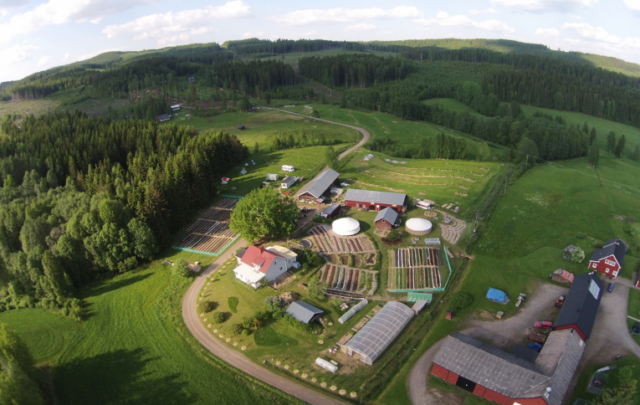
This is the twelfth installment of an exploration of some of the possible futures discussed on this blog, using the toolkit of narrative fiction. Our narrator attends the Lakeland Republic’s annual drone shoot, and finds out that not all technological innovations start out from the current state of the art…
***********
A rooster yelling at the top of its lungs woke me before dawn the next morning. It didn’t seem likely to shut up any time soon, and I doubted the New Shakers would be happy if I threw things at their livestock, so I got up instead. I rang the bell as I’d been told, and a couple of minutes later, a quiet knock on the door announced the arrival of a middle-aged woman with two pitchers and a bowl. I took them and thanked her; she smiled and curtseyed, and headed off to somewhere else.
I started washing up, and only then realized two things. The first was that there weren’t any outlets for electricity in the room; the second was that the only thing I had to shave with was an electric shaver. I finished washing and got dressed, hoping a day’s growth of beard wouldn’t be a faux pas by Lakeland standards. Maybe half an hour later, I was sitting behind Colonel Pappas in the jeep as it rattled over a dirt road on its way to the Lakeland Republic’s annual drone shoot.
“How much do you know about modern drones?” Pappas had asked me the night before; when I admitted my ignorance, he laughed. “Fair enough. You start talking about drones, a lot of people think of the old first and second generation machines, the ones that used to launch rockets from a mile or so in the air. Those haven’t been in frontline service since the ‘thirties—ever hear of the battle of Mosul?”
I tried to remember. “That was in the second Kurdistan war, wasn’t it?”
“Bingo. Both sides had drones, but the Kurds figured out that you can target them with old-fashioned antiaircraft guns, got a bunch of those in place without anybody being the wiser, and took out most of the Turkish drone force in an afternoon. After that, you had militaries all over the place figuring out ways to target drones, and that’s when the sort of drones you see these days started popping up on the drawing boards—observation drones way up where artillery can’t hit them, and attack drones flying at treetop level where they can hide from radar. Of course then they’ve got other vulnerabilities.”
“Can’t they simply reprogram their attack drones to fly high if they’re going to attack you?”
“Sure.” He grinned. “We’ve got plenty of old-fashioned antiaircraft guns, too.”
So there I was, jolting along a rough road with brown fields of stubble to the left and a line of trees to the right, and a moving dot up above the trees caught my eye. I turned to look; Pappas saw me move, turned in his seat, and handed me a pair of binoculars. Despite the joggling of the jeep, I managed to get the thing in focus: a lean angular shape with broad straight wings, flying low and fast.
As I watched, shards suddenly flew up from the middle of one wing. A moment later the outer half of the wing tumbled one way and the rest of the drone tumbled the other. I managed to follow it most of the way to the trees, then handed the binoculars back to Pappas.
“Wing hit?” he asked, pitching his voice to be heard above the jeep’s engine. I nodded. “That’s the easy one,” he went on. “Good shots aim for the engine or the fuel tank.”
A quarter mile or so on, as another drone came into sight, the road veered suddenly to the right, ducked through the trees, and stopped in an impromptu parking lot where jeeps were more or less lined up. Just past the parking lots was a cluster of olive-drab tents, and past those a fair-sized crowd. Off to the left, though, a bunch of horses were munching grass in a fenced-off field, and as I watched, a dozen or so people in Lakeland Army uniforms rode up on horses, dismounted, and led the animals into the field.
The jeep rolled to a halt. “What’s with that?” I asked Pappas. “Cavalry in this day and age?”
“Nah, dragoons.” He figured out from my face that I didn’t know the word, and went on: “Mounted infantry—they ride to the battlefield and then dismount to fight. Most countries had ‘em until the end of the nineteenth century, and we tried ‘em out in the war of ‘49 with good results. Transport’s a lot less difficult on the logistical end of things if the only fuel you need is hay.”
I got out of the jeep. Pappas hauled himself into his wheelchair, then handed me a pair of earplugs. “You’ll need these,” he said. “Drone rifles use .50 caliber ammo, and that isn’t easy on the ears.”
We wove our way through the tents, through the crowd, and out to the places where the guns were firing. There were maybe two dozen of them in a big arc, each with twenty or so stations for shooters, though things were just getting under way and most of the stations didn’t have anyone at them yet. “Those are first timers doing their qualifying rounds,” Pappas said, pointing to one set of stations filling up quicker than the others; the earplugs muffled his voice but I could still hear him. “Over here, the expert marksmen—you’ll see some of the best shots in the Republic here today. Check this one out.”
“This one” was a short middle-aged woman in jeans and a buffalo plaid wool shirt, cradling a rifle that must have been as long as she was tall. Past her, I could see a dot against the morning sky. She lined up the shot with practiced ease. Even through the earplugs, the crack of the rifle was loud enough to sting.
A moment later, off in the distance, the dot vanished in a little red-orange flash.
“Sweet,” Pappas said. “Right in the fuel tank. That’s Maude Duesenberg—I honestly don’t remember how many drone shoot trophies she’s got on her mantle, but it’s got to be getting crowded.”
“Where do you get all the drones?” I asked him.
“Oh, most of ‘em we make ourselves. Expert class and proof-of-concept shooters get real drones—we buy them through traders in Chicago. You probably don’t want to know how many officers in how many countries sell us a drone or two every year, list ‘em as crashed, and pocket the proceeds.”
I knew enough about the military back home to guess that the Atlantic Republic was on that list. Still, something else had sparked my curiosity. “What’s proof of concept shooting?”
“New or revived technologies. They’re over on this side—let’s check ‘em out.”
Instead of the shooter’s stations elsewhere on the arc, the place for proof-of-concept shooters was an open patch of mostly flattened grass with a long straight view ahead of it. There wasn’t much of a crowd there, just a couple of officers in the ubiquitous Lakeland trench coats, and several dozen kids watching with hopeful looks on their faces. Out on the grass were maybe twenty soldiers who looked even scruffier than I felt, manhandling what looked like a cannon on an oddly shaped mount.
“Oh my God,” Pappas said. “I know these guys—the 34th Infantry from Covington. I wonder what they’re up to; that can’t be an ordinary howitzer.”
I gave him a startled look. One of the officers standing there laughed, and said, “Good morning, sir. Yeah, Carlos and I have been wondering about that since they started setting the thing up.”
Introductions followed; Michael Berconi and Carlos Lopez Ruiz were captains in the Lakeland Army, down from Toledo to watch the proof-of-concept tests. “You probably don’t know about the 34th,” Lopez said to me. “They’re a bunch of maniacs. Every year they come up with some new stunt.”
“That’s for sure,” said Berconi. “You should have been here last year. We were standing here, and all of a sudden a bright red triplane—you know, like the Red Baron’s plane—comes over the trees there and starts jumping drones from above. I heard later they spent two years building the damn thing.”
“I’m surprised the drones didn’t dodge it,” I said.
“They couldn’t see it,” Pappas told me. “Military frequency radar won’t see wood and fabric, and military drones only have video looking forward and down—though I understand that’s being changed. You’re not the only visitor from outside at these events.” He grinned, though there was an edge to it. “Though most of the others don’t announce themselves.”
The soldiers out on the open grass had finished setting up their cannon, and one of them spread his arms in what was pretty obviously a signal. “Here goes,” Pappas said. “You may want to put your hands over your ears; a 75-mm howitzer makes more noise than your earplugs’ll handle.”
I covered my ears. Off in the distance, a dot rose up into the air and came toward us in a zigzag pattern. About the time it got close enough that I could see more of it than a dot, the cannon went off, and Pappas wasn’t kidding; even with my hands over my ears, it packed a wallop. Something blurred the air downrange from where we stood; an instant passed, and then the drone shattered as though it had slammed into an unseen wall. The watching kids whooped; so did the soldiers, and then reloaded.
“What the ringtailed rambling—” Pappas began to say, then covered his ears; he’d spotted the next drone a moment after I had. The same process repeated, except that the second drone only lost half of one wing; that was enough to send it tumbling down onto the range, but the chief of the gun crew regaled the others with a string of profanity that would have gotten a standing ovation from Marines. Then it was hands-over-ears time; they let the final drone get good and close before firing, and so I got a fine view as something slammed into it and sent the fragments tumbling down to the grass below.
Before the soldiers had finished whooping Pappas wheeled out toward them, shouting, “What the hell are you maniacs putting in that thing?” He was apparently no stranger to the 34th Infantry; they greeted him with sloppy salutes and big grins, and the crew chief and one of the others stood talking with him while the others started breaking the cannon down for transport.
A woman’s voice sounded behind me: “Excuse me, is this the place for proof-of-concept tests?”
I turned around. She was a twenty-something blonde in a big brown barn coat. “Yes,” I said. “They’re just packing up from the last test.”
“Oh, good.” She turned and waved, and someone hauling a cart with two bicycle wheels came out of the crowd. He turned out to be a young man of about the same age, in a fedora and trench coat that had seen quite a bit of hard wear; one of his shoulders was noticeably higher than the other.
“Are you with the soldiers?” she asked me.
“No, just visiting. I’m Peter Carr.”
“I’m Emily Franken, and this is my husband Jim.” Hands got shaken all around. The cart was full of what looked like antique radio gear—a couple of big metal boxes with dials, switches, and gauges all over the front, and something that I swear looked like a death-ray gun from some old skiffy vid. The kids craned their necks to look at it all, but had the common sense not to touch anything.
“Should I ask about that?” I motioned to the contents of the cart.
“Sure,” she replied. “It’s a maser—a microwave laser. It’s old tech—they made them in the 1950s, but nobody could figure out how to get real power out of them.” In response to my look of surprise: “There’s a lot of things like that—interesting bits of technology nobody followed up on.”
“What Emily’s not saying,” Jim interjected, “is that she spent two years studying quantum mechanics to find something that would mase steadily at room temperature, and published a couple of papers that are going to turn three or four branches of physics on their heads.”
“Oh, stop it,” she said, blushing.
“Not a chance. When we were in engineering school, Mr. Carr, Emily was the only person in class who came up with anything really interesting for me to build.”
“And Jim was the only one in the class who could build the things I needed for my projects—so of course we got married right after graduation.” Laughing: “When he proposed, he said I had to marry him so I’d almost have the right last name to be a mad scientist, and a hunchbacked lab assistant too.”
He grinned, pushed his raised shoulder up further, and gave me a bug-eyed look. I laughed.
Out on the grass, the soldiers had the cannon and mount set up for transport, and hauled it back toward the parking lot and the jeeps. I wished the Frankens good luck, and they hauled the cart of electronic gear out onto the field. They passed Pappas as he came wheeling back, shaking his head.
“Even for the 34th, that’s pretty good,” he said when he reached me and the two captains. “You know what they were shooting? Canister shot.”
Lopez and I looked blank, but Berconi let out a startled laugh. “Seriously?”
“God’s honest truth.” To the rest of us: “It’s something artillery used to use back in the Civil War and before—basically, the world’s biggest shotgun shell, with pellets half an inch across.” With a motion of his head in the direction of the Frankens, who were busy setting up their gear: “What’s that all about?”
“Some kind of twentieth century microwave laser,” I said.
Pappas gave me a startled look, then turned to Berconi. “What’s on their schedule?”
“Standard three trials—well, but they’ve requested one with live ordnance.”
Pappas let out a long whistle. “This could get colorful.”
Out on the grass, the two had finished setting up their gear: a row of batteries, the two boxes, the death-ray-thing on a tripod, and cables connecting them. Emily Franken signaled that they were ready, and then got behind the ray-thing and aimed it downrange while her husband hunched over the two boxes and fiddled with the dials. The first drone appeared in the distance. I’m not sure what I was expecting—flashes and bangs, a beam of light, or what have you—but all that happened was that the drone suddenly dropped out of the air as though the Frankens had flipped the off switch at a distance.
A second drone met the same fate a few minutes later. “The third—” Pappas said.
“That’ll be the one with heat on board,” Berconi told him.
By the time the third drone went up people were beginning to drift over to the proof-of-concept range, wondering what was going on. As it came close enough to be more than a distant dot, I could see two missiles under each wing. Emily Franken crouched behind the device she was aiming, Jim twisted dials and fiddled with switches, and all of a sudden the drone vanished in a flash and a bubble of red fire. The sharp crack of the explosion, muffled by the earplugs I was wearing, arrived an instant later. The watching kids whooped in delight.
Berconi and Lopez hurried across the grass to the Frankens the moment the flaming wreckage of the drone was on the ground. “What do you think?” Pappas asked me.
“I have no idea,” I admitted. “What did they do, microwave the inside of the drones?”
“Good question. If I had to guess—well, you know how a radio antenna works? Radio waves hit a piece of metal the right length and set up a current in it? I wonder if they’ve tuned the thing so that it sets up electrical surges in the onboard computer chips and the fuses for the missiles.”
I gave him a horrified look. “You could fry anything electronic with that.”
“Not our gear. All our electronics use vacuum tubes—you hit those with a surge, they just shrug—but outside electronics? Pretty much, yeah.”
I considered him for a long moment, and then wondered whether this whole business had been staged for my benefit. “You get a lot of mad scientists here in the Lakeland Republic?”
“You’d be surprised,” he said with a grin. “Lots of technologies that got invented in the nineteenth and twentieth centuries were just plain abandoned even though they worked fine—there wasn’t a market yet, or something else got there first, or somebody bribed the right officials so government policy favored some other technology instead. A lot of engineers here spend their time going through old technical journals and what have you, looking for things that the Republic can use.”
“Like canister shot,” I said.
“Bingo. Or masers, or dragoons—or for that matter canals and canal boats.”
The Frankens had their maser broken down and loaded on the cart, and they were hauling it away, still deep in conversation with Berconi. Lopez headed back our way, while a bunch of soldiers hauled something that looked like a hand-cranked Gatling gun out onto the grass. “Come on,” Pappas said then. “Unless you want to see more here, of course. The expert competition ought to start pretty soon.”
Photo credit: "Onyxstar Fox-C8 XT xender 360" by ZullyC3P – Own work. Licensed under CC BY-SA 4.0 via Commons.






